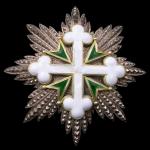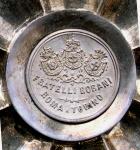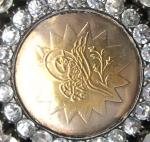-
Posts
782 -
Joined
-
Last visited
-
Days Won
2
Content Type
Profiles
Forums
Blogs
Gallery
Events
Store
Everything posted by Veteran
-

France Panzer Lied - Depart of the Foreign Legion Cavalry
Veteran replied to Chris Boonzaier's topic in France
HI Bernhard Cutting down on Government expenses has also affected the armed forces. The Foreigh Legion seems to have been relatively protected. But garrisons have been changed for various reasons. Etranger Cavalerie have been, I understand, moved to one of the permanent training grounds where they will settle. They can be trusted to make a success out of it. Veteran formaly IIIrd Bat. Regiment de Marche de la Legion Etrangere -

France Legion of Honor, Knights Cross from First Empire era
Veteran replied to Bernhard H.Holst's topic in France
As an addition, the hallmark on the suspension ring looks like Roman lictor's fasces which would be the true proof. That was the hallmark for silver during the First Empire. Could you confirm that? Nice period piece. -

France Legion of Honor, Knights Cross from First Empire era
Veteran replied to Bernhard H.Holst's topic in France
This looks very much like a 3rd type Napoleon I Legion of honor badge. -

France unknown medal on a medalbar from a german legionnaire
Veteran replied to dedehansen's topic in France
Bison is right about this medal being awarded to civilian prisonners during the German occupation of North and Eastern France in the Great War. It seems to have also been, improperly, added to medal bars by military personnel who had been captured by ennemy forces. This man could have been a prisonner with the Viet. This would be an UNOFFICIAL addition to an otherwise legitimate group. Regards Veteran -
I would think Rogi is partially right In addition to the Grand Cross of the Legion of honor, he restricted the awards displayed to what he considered the more significant ; the two crox de guerre (1939 2/3 mentions in dispaches MID, TOE for Indochina 8 MID) + the Cross for military valour (10 MIDs° along with the Woundeds' badge with 4/5 combat wounds. Considering such set of awards, the combattant's cross would be redundant. The french custom of wearing long enough ribbons to accomodate the stars and palms which go with each cross, added to régulations limiting the number of awards on a same line to four. Any other display would have looked rather messy. This old warrior makes a striking picture. Hope these few remarks will help.
-
Yankee That box is clearly a Napoleon III Legion of honor period. It could very well have housed a badge awarded for the Crimean Campaign (or the Italian, China, Mexican campaigns). But it CERTAINLY COULD NOT HAVE BEEN AWARDED for the Franco-Prussian War 1870/71; this is because Napoleon III was deposed at the very start of the war, when he was personnally captured by the Germans after the defeat at Sedan. Legion of honor awards were only resumed after the design was changed to what would be the IIIrd Republic type, with the wreath of laurel and oak leaves instead of the imperial crown. Keeping up with French goverment changes during the XIXth Century is quite chalenge, I fear.
-
Hello Robin An other nice piece. It certainly is silver if the boar's head hallmark is present. If you don't mind me saying so, this hallmark has been used throughout the country for silver. Strangely the Paris Mint uses an entirely different type of silver hallmark which has changed with from time to time since 1832. In fact, the Paris Mint refrained from manufacturing badges of the Legion of honor for a very long time Their job really was to strike coins and medals (awards and table medals), the more rafined badges with enamels being considered rather to be the job of legitimate jewellers. This is why the boar's head hallmark is the right one for a Chevalier of the Legion of honor's badge. You seem to be building up quite a collection of Legion of honor badges. Congratulations
-
Hello Paul I unfortunatally don't have an "Almanach Imperiel" for the years 1856 and later which would have listed at least French C.B.s and higher ranks. But I have found 2 GCB (Marechal CANROBERT & Marechal MAC-MAHON) and 10 KCB in the Almanach National 1875, who were vétérans of the Crimean war. CBs were not listed. Therefore a number of French honorary CBs must have existed. But as we are both agreed, they probably were not many. All the best Paul
-
IIIrd Republic badges of the Legion of honor were made by hundreds of thousands between 1871 and 1954. All major firms not only made their own designs, and they usually had a choice of different styles, rangeing from the cheaper to the outstanding jeweller's quality with added diamonds or coloured stones. The range of prices was 1 to x 10/20, Remember, recipients of French awards buy their own insignia. In many cases, these are traditionally presented as a token of appreciation by colleagues and friends. This explains why two badges bought at random have every chance to be different. Your badges look fine. One shows the natural damage on a badge whch was often worn, possibly by an officer. The other is in excellent condition. Nice buys !
-
Thank you both for this information. It seem that most officers in those ranks received the Legion of honor. I believe a number of French officiers received the Order of the Bath, but badges don't turn up often .... Best regards Veteran
-
A very nice badge. Congratulations. Would you know how many Brtiish colonels were awarded the order ? I rather doubt they would all have recevied it.
-
Thank you all for the useful information provided. Paul's opinion added to Claudio's most interesting suggestion.is exactly what I needed. I had a hunch this was a rather unusual mark, but I did not realize it probably had such a short period of use. Hope to be of the same help to both some other time. Veteran
-
Hello all, I have been trying to date this breast star (unfortunalely with enamel missing on the cross of St.Maurice) Could someone suggest a date considering the reverse shows this FRATELLI BORANI maker's mark ? I believe this firm was bought up by CRAVENZOLA at one time, but this is uncertain.. Thanks for your help. It will be fully appreciated. Veteran
-
Congratulation, Bison, for this well documented group. Quite unusual to find a group of decorations to a same officer so well preserved with their presentation cases.. Thanks for sharing. Veteran
-
This badge was lot n°173 in the January 2014 auction sale at Drouot's in Paris, Beaussant-Lefevre being the aucionneers. According to the results published by the firm after the sale, this particular early badge was auctionned at 16.000 €uro (20.000 €uro with costs and taxes). I hope this answers your question. Veteran
-
Hi Demir Thank you once again for this precious information; these badges are beautiful and facinating. I am most grateful Veteran
-
Thank you very much, Demir, for your kind help. This is exactly what I needed. I understand badges given to Turkish recipients were recalled and exchanged, badges awarded to foreign recipients only were retained. This would explain why ther are scarce. Two other badges have been seen recently in Paris; One is shown as part of the outstanding SPADA collction housed in the Legion of honor Museum. It is distincly smaller then this one and the tugra is difficult to read through the glass cover protecting it; The other was offered for sale at an aucion also in Paris last January. The badge was slightly smaller and I think the tugra could possibly be different. I wonder if you could help on this one too. With my very grateful regards Veteran
-
Hello everyone It seems badges of this order were awarded between 1831 ane 1861, when the order of Medjidje was created. Some sources mention later awards I understant the center part of the badge shows the "tugra" of the reigning Sultan at the time of issue. Could this badge be dated in this way ? Every bit of information will be gratefullyr received. Veteran
-
You are absolutely right .... obverses changed with each change of political regime. And they also changed during reigns of kings or emperors. Very much in the same way coins changed. Trying to pin down dates when changes really occured is one of life-saving medals collectors' fun-thing; There is still lots of room for further knowledge, since the only way to tell is to find the dates of awards of kown medals., check the style of the medal and record it. You are welcome to join the (very small) crowd if and when you feel like it. Best regards Veteran
-
Hello Chris and Bernhard The combat uniform worn by this figure is reasonnably accurate. Except for a few mistakes : The white kepi was, of course, strictly out. Only worn on parade with the blue wollen belt. Never with combat gear (a U.S.Army kzki forage cap was worn as a service cap). A "caporal chef" (white kepi with golden band would° have worn a regulation Legion grenade badge with two green and a golden chevrons for rank. The heavy combat helmet NEVER would have been painted RMLE !!! German sharpshooters were very good and needed no encouragement of the kind. I cannot remember exactly when the French 1st Army RHIN & DANUBE badges were first issued. But I suspect they were after the RMLE had been reverted to 3rd Foreign Legion infantry Regiment (3e REI) on July 4th 1945. A RMLE legionnaire would therefore not have worh it with his combat gear during the Liberation of France and German campaigns from October 1944 through May 1945; . Regards Paul
-
Hi Chris If I am right to assume that this figure is made to recall uniforms worn by men of the Regiment de Marche de la Legion Etrangere (R.M.L.E) during the French Liberation and Germany campaigns in 1944/1945, a few points might be worth mentionning. The first is that the overall combat equipment is quite accurate. Basic U.S. Army uniforms were in use as shown. The rifle is correct as are the additionnal equipments. Some men had that rifle (not the Garrant M1). I personnally had a Thompson submachinegun. A small number of points might, nevertheless, be made. This legionnaire is equipped for combat with the heavy helmet. In such a case he would NEVER have worn a brigadier-chef's white kepi. In those days, it was only worn on parades, with one's weapon but not with the full combat equipment. We wore a U.S. Army kaki field cap (calot, in French). If this was a brigadier-chef, he would have worn the Legion grenade on this sleeve with the appropriate two green chevrons under a gold one; A heavy combat helmet would NEVER have been painted with R.M.L.E. The Germans had very efficient sharpshooters who needed no encouragement of the sort. The RHIN & DANUBE badge was a later adjunct to the uniform. I am not clear as to when it was issued, but I would think some time in the summer of 1945. One should remember that the R.M.L.E. was dissolved on July 5, 1945, the regiment becoming the 3re Foreign Legion Infantrly Regiment. (3e R.E.I.) which still exists and wears the U.S. Presidential Unit badge we earned. In other words, we probably never wore the RHIN & DANUBE badge while with the R.M.L.E. This being said, a very well made figure. I understand how difficult it can be to be accurate after such a long time. My own recollections might also be dimmed by age.... Hope this helps..
-
Stuka is right about the first badge. It belongs to the "Scouts de France", the Roman Catholic scouting organisation (Jerusalem cross with a fleur-de-lys". The walking stick with the V-shaped upper end could be the Rover-Scouts branch (young adults). The meaning of the axe would have to be cleared. Hope this helps; Veteran
-
This makes sense. Such matters are not of national importance and would not have to be published in the Moniteur or Journal Officiel. On the other hand, ALL official awards of French life-saving medals issued by one of the Government Minsitries were published. They are sometimes hard to find, but there they are.... or were when it comes to awards to foreign recipients, since the 1870s.
-
The changes from one effigy to the next just occured as they did on coins and postage stamps. No official statement or law are known to have existed, although instructions certainly must exist in the Archives of the Paris Mint. To my knowledge? they have not been examined by collectors or researchers. For this reason, collectors are trying to narrow down the dates when changes occured by recouping known medals of each types with the dates when the medals were published in the Journal Officiel or its predecessor the Moniteur.







